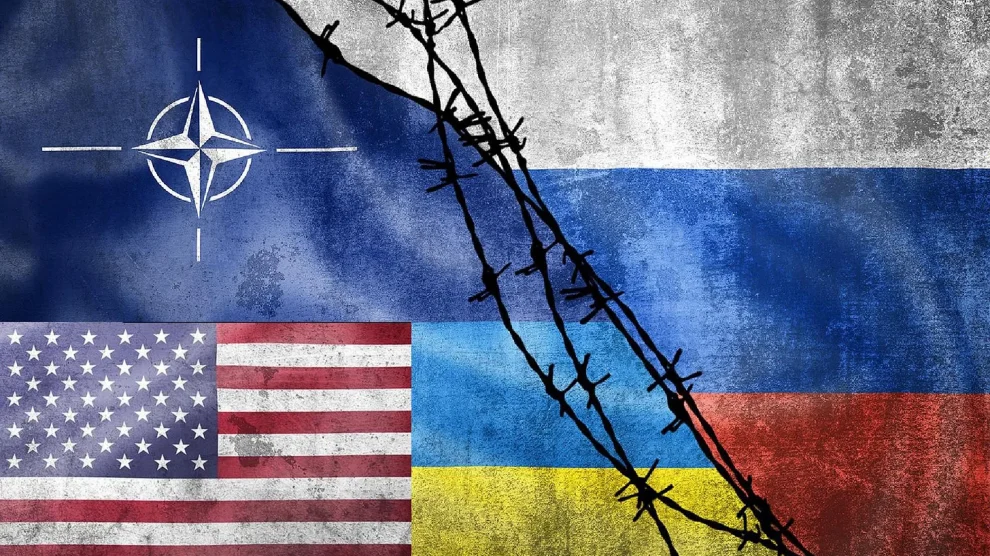
By VIKTOR PLAKHUTA
Ukraine’s bilateral relations with the United States, having emerged after Ukraine gained independence in 1991 as a result of the collapse of the USSR, have been evolving for more than 30 years, having received its greatest development with the beginning of the Russo-Ukrainian War.
Taking into account the economic and military potential of the U.S., its role in regional conflicts and influence in international organizations, the analysis of Ukraine’s cooperation with the United States and the development of recommendations for consolidating the existing level and further development of relations is extremely important, and is determined, in particular, by the following:
(1) the need to counter Russia’s full-scale armed aggression encourages Ukraine to build close military and political relations with leading Western countries;
(2) the Russian-Ukrainian war is taking place during Great Power Competition with the danger of a “great war” in Europe and a possible escalation into a world war;
(3) the weakness of global security institutions directs Ukraine to strengthen bilateral cooperation with NATO countries, primarily with the United States, since
- the U.S. assistance is the most important factor for Ukraine to preserve its sovereignty and to transform into a successful democracy,
- The United States is the world’s largest economy with the strongest high-tech military; U.S. and its allies and partners maintain global technological leadership,
- The United States provides the largest amount of military and technical assistance to Ukraine among all countries,
- the United States has well-established economic and political interests in Europe and on the Eurasian continent; Ukraine is able to perform a stabilizing (deterrent) function against expansionist regimes, while being an important logistics center,
The United States sees Ukraine as a means to weaken Russia in the US-China-Russia triangle;
(4) the current level of cooperation with the U.S. is unprecedented for Ukraine, which is not only crucial for preserving Ukraine’s sovereignty, but also important for the security in Europe;
(5) there are examples of bilateral relations between the U.S. and other countries that Ukraine can follow: the success stories of US relations with such countries as Israel, the Republic of Korea, and Japan (especially in the context of these countries’ cooperation with the NATO Alliance).
EVALUATION INDICATORS
I would say that when analyzing the level of bilateral relations, it is necessary to keep in mind certain evaluation indicators (WITHOUT ranking by degree of importance):
(1) degree of U.S. interest in Ukraine’s deterrence of expansionist regimes;
(2) level of agreement between two countries on the strategy and conditions for ending the war and Ukraine’s accession to NATO;
* Some members of Congress expressed concern that the United States does not have a “strategy for Ukraine’s victory over Russia.
(3) asymmetry in military and economic power between the two countries;
(4) vulnerability of bilateral relations to changes in political elites;
(5) Ukraine’s dependence on U.S. military and technical assistance during martial law and in the postwar period;
(6) military-technical cooperation and implementation of agreements in this area;
(7) influence of the Ukrainian diaspora in promoting Ukraine’s interests in the United States;
(8) destructive russian influence on the American population and politicians;
(9) corruption in Ukraine, completeness of reforms (courts, property protection, de-oligarchization);
(10) involvement of American business in Ukraine.
BASIC ASSUMPTIONS
(1) Countering full-scale armed aggression and indirect US involvement in this process is the cornerstone of bilateral Ukraine-US relations;
(2) The current state of Ukraine’s bilateral relations with the U.S. can be defined more as Ukraine’s dependence on the U.S. rather than a partnership, given the importance of the Eastern European region for the Americans. Ukraine is mainly forced to act through a system of bilateral agreements;
(3) The United States uses its relations with Ukraine (military and financial assistance) to strengthen its weight in European affairs and to maintain its status as a superpower. Thus, Ukraine’s relations with the United States directly affect the US position in Europe, in NATO, and the world in general;
(4) For Washington, the existence of a constant threat from Russia and its allies (primarily China) justifies the need to develop relations with Ukraine;
NATO remains the largest military-political bloc, ensuring the promotion of the U.S. national interests in Europe: the U.S. presence in Europe and the projection of military power outside the North Atlantic region gives Washington a “leverage” in European affairs.
(5) For Ukraine, relations with the United States in the current geopolitical realities are one of the main factors in preserving state sovereignty. Therefore, systematic cooperation with the United States in the military-political, military-technical and economic spheres is a high-level priority;
(6) Currently, the central pillar of Ukraine-U.S. relations is cooperation in the military sphere;
(7) In the political sphere (the second pillar of relations), where the personal factor is of great importance, relations are increasingly acquiring the status of special.
(8) Economy and finance are the third pillar, where the most significant are
- financial support for the Ukrainian economy during the war,
- potential cooperation in the field of foreign direct investment, particularly in the period of post-war recovery,
- energy sector (nuclear energy and nuclear security),
Of particular importance will be the US participation in the country’s post-war recovery and industrial development;
(9) The Ukrainian establishment does not question the need to develop bilateral relations, primarily in the military sphere, in order to
- preserving the country’s sovereignty and ending the war on favorable terms for Ukraine,
- post-war preservation of the country’s independence and development of an integrated system of deterring external aggression (in the military, economic, information and other spheres),
- post-war restoration of industry and infrastructure;
(11) Considering the cooperation between the two countries, one should also understand the existing contradictions, in particular, regarding
- the outcome (scenarios) of the Russian-Ukrainian war,
- the scope and nature of US assistance to Ukraine,
- Ukraine’s participation in military and political blocs (e.g. NATO),
- post-war security system in Europe and security guarantees, etc.
The Integrated Country Strategy (ICS)
The Integrated Country Strategy (ICS) is a multi-year strategic plan that articulates a common set of priority goals and objectives for a U.S. diplomatic mission in a particular foreign country. The plan is a product of the State Department, which draws on input from other parts of the U.S. government, including the Department of Defense. The plan includes a list of goals, a timeline for achieving them, and milestones that U.S. officials would like to see achieved. The State Department releases such strategies for many countries every few years (3-4 years).
As of the date of approval of the latest version of the US Integrated Strategy for Ukraine (August 29, 2023), the following Strategic Framework for the US Mission to Ukraine was defined:
MISSION OBJECTIVE 1. To win the war: Ukraine effectively uses security, humanitarian, economic and diplomatic instruments to win on the battlefield and create conditions for a just and lasting peace.
MISSION OBJECTIVE 2: Winning Peace: Ukraine strengthens its civil society, democratic and economic institutions, and implements anti-corruption reforms to achieve sustainable momentum toward Euro-Atlantic integration and win a secure and just future that ensures prosperity for all its citizens.
MISSION OBJECTIVE 3. Hold Russia accountable: Ukraine and its allies will hold Russia and its actors accountable for war crimes and damage to Ukraine.
MISSION OBJECTIVE 4. Report to U.S. Taxpayers: Humanitarian, economic, and security assistance provides effective assistance and sustainable results for Ukrainians.
RECOMMENDATIONS
(1) Formulation of “Ukrainian Grand Strategy “
This is particularly important when there is an enemy to be defeated. To this end, policymakers seek to develop the best possible way to coordinate military instruments, political leverage, diplomatic capabilities and economic means within a unified national strategy.
(2) In the context of the formation of the Ukrainian Grand Strategy, it is necessary to form a joint military strategy with the United States, in particular
- joint military strategy for the course and conditions of the end of the Russian-Ukrainian war, the post-war security system in the region,
- formulation of options for joint actions in scenarios where the Russian-Ukrainian war goes beyond the borders of Ukraine and/or military conflicts appear in other regions of the world
Simultaneous conflicts. After Russia’s invasion of Ukraine in 2014, it became clear that the United States faced a fundamentally different world in which the main adversaries were not rogue states but large powers with enormous military potential, including nuclear.
The United States no longer proceeds from the security necessity of simultaneously waging two regional conflicts with rogue states, but from the requirement to win a high-intensity conflict with the top-tier countries (China and Russia). Adoption of this concept requires a significant increase in the size of the US armed forces and the size of the defense budget.
Therefore, the role of Ukraine with its army and experience is very valuable: if there is a possibility of simultaneous military conflicts in two or more theaters of war, the United States already has an experienced ally in the region.
(3) Agreement on Major Non-NATO Ally status
Despite its importance to US national security, in many respects Ukraine is viewed as a mere partner, not a true ally – Ukraine does not even have the status of a major non-NATO ally, a status enjoyed by Tunisia and Afghanistan.





